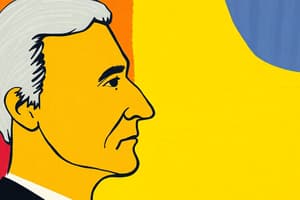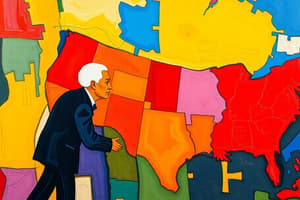Podcast
Questions and Answers
Which economic ideology's decline is associated with Margaret Thatcher and Ronald Reagan hammering the 'final nail'?
Which economic ideology's decline is associated with Margaret Thatcher and Ronald Reagan hammering the 'final nail'?
- Monetarism
- Supply-Side Economics
- Keynesian Economics (correct)
- Classical Economics
What is a core tenet of the 'Washington Consensus' concerning public services?
What is a core tenet of the 'Washington Consensus' concerning public services?
- Expanding public services to ensure universal access
- Maintaining public services with increased efficiency
- Integrating public services with private sector initiatives
- Dismantling public services, including healthcare and safety nets (correct)
In what year did the economic policies come to be known as the Washington Consensus?
In what year did the economic policies come to be known as the Washington Consensus?
- 1979
- 1999
- 2009
- 1989 (correct)
According to the Washington Consensus, how should market forces operate?
According to the Washington Consensus, how should market forces operate?
What strategy did the U.S. employ regarding multinational corporations (MNCs) within its borders for nearly two decades?
What strategy did the U.S. employ regarding multinational corporations (MNCs) within its borders for nearly two decades?
Which policies did the US maintain, reflecting a protectionist approach?
Which policies did the US maintain, reflecting a protectionist approach?
What was the suggested remedy prescribed by the World Bank and IMF during Latin America's debt crisis in the 1980s?
What was the suggested remedy prescribed by the World Bank and IMF during Latin America's debt crisis in the 1980s?
Which of the following is a component of the 'recipe' applied by the World Bank and IMF?
Which of the following is a component of the 'recipe' applied by the World Bank and IMF?
According to the Washington Consensus approach, what should happen to the role of the state in the economy?
According to the Washington Consensus approach, what should happen to the role of the state in the economy?
What is one potential negative effect of states becoming reliant on foreign investment?
What is one potential negative effect of states becoming reliant on foreign investment?
What is a potential consequence of states becoming trapped in production while MNCs siphon profits to the North?
What is a potential consequence of states becoming trapped in production while MNCs siphon profits to the North?
What was the primary aim of the original Washington Consensus related to debt?
What was the primary aim of the original Washington Consensus related to debt?
What was considered a key strategy to combat inflation within the framework of the Washington Consensus?
What was considered a key strategy to combat inflation within the framework of the Washington Consensus?
According to the information presented, what is a potential consequence for countries that suffer from a trade deficit?
According to the information presented, what is a potential consequence for countries that suffer from a trade deficit?
What is the Washington Consensus' approach to taxes to attract MNCs?
What is the Washington Consensus' approach to taxes to attract MNCs?
What does trade liberalization involve regarding tariffs?
What does trade liberalization involve regarding tariffs?
What does the full implementation of copyrights aim to achieve, according to the content?
What does the full implementation of copyrights aim to achieve, according to the content?
In order to attract capital for investments, what does the content suggest should be eliminated?
In order to attract capital for investments, what does the content suggest should be eliminated?
What does the free flow of capital include?
What does the free flow of capital include?
According to Williamson, what type of economic policy should the reforms be?
According to Williamson, what type of economic policy should the reforms be?
Williamson argued that his 1990 article was that it was in need of a certain recipe, what recipe did he mention?
Williamson argued that his 1990 article was that it was in need of a certain recipe, what recipe did he mention?
Which statistic does Norberg highlight as a positive economic indicator since 1965?
Which statistic does Norberg highlight as a positive economic indicator since 1965?
Against what does UNDP (1997) suggest developing countries are making progress?
Against what does UNDP (1997) suggest developing countries are making progress?
In the context of trade deficit management, what immediate action is often required to finance the deficit?
In the context of trade deficit management, what immediate action is often required to finance the deficit?
What long-term goal does the privatization of sectors aim to serve within the Washington Consensus' framework?
What long-term goal does the privatization of sectors aim to serve within the Washington Consensus' framework?
Flashcards
Washington Consensus
Washington Consensus
Economic policy recommendations by institutions like the IMF and World Bank in the 1980s.
Neo-Liberalism
Neo-Liberalism
An economic approach that emphasizes privatization, deregulation, and free markets.
Privatization
Privatization
The shifting of services or industries from public to private ownership and control.
Deregulation
Deregulation
Signup and view all the flashcards
Balance of Payments
Balance of Payments
Signup and view all the flashcards
Trade Deficit
Trade Deficit
Signup and view all the flashcards
Protectionism
Protectionism
Signup and view all the flashcards
Trade Liberalization
Trade Liberalization
Signup and view all the flashcards
Exchange Rate
Exchange Rate
Signup and view all the flashcards
Foreign Direct Investment (FDI)
Foreign Direct Investment (FDI)
Signup and view all the flashcards
Life Expectancy
Life Expectancy
Signup and view all the flashcards
Absolute Poverty
Absolute Poverty
Signup and view all the flashcards
Tariffs
Tariffs
Signup and view all the flashcards
Copyrights
Copyrights
Signup and view all the flashcards
Currency depreciation
Currency depreciation
Signup and view all the flashcards
Market Integration
Market Integration
Signup and view all the flashcards
Cutting the state
Cutting the state
Signup and view all the flashcards
Study Notes
- The Washington Consensus is a doctrine or imperialism that is being resurrected
- Part 3 of the study session was held on Jan 13 and covers the views of Williamson and Norberg
Context
- The era of Margaret Thatcher and Ronald Reagan brought an end to Keynesian economics
- The late British PM Thatcher and Reagan advocated for Friedman-Von Hayek recipes
The Washington Consensus
- Officially known as the Washington Consensus in 1989, it involved the following :
- Privatization of the public sector
- Dismantling of public services
- Deregulation of labor laws
- Market forces were allowed to decide everything
US vs The South
- The US supported the freedom of MNCs locally for nearly two decades
- The Free Trade Commission in 2025 will face challenges in enforcing American laws on large corporations
- The US maintained protectionist policies through anti-dumping tariffs, security based tariffs, and copyrights/patents
The Recipe
- In response to Latin America's debt crisis in the 1980s, the World Bank and the International Monetary Fund used the Washington Consensus as a remedy
- The remedy included:
- Liberalizing trade
- Deregulation of laws
- Integrating the financial sector with FDI
- Free flow of capital
- Rolling back the state
Effects
- The South experienced a knowledge gap, leading to challenges in development
- Local establishments were demolished, and some were reliant on MNCs
- States heavily relied on foreign investments, making them vulnerable to market fluctuations.
- Labor exploitation happened, and became a sacrifice for developing states to attract MNCs
- States were trapped in production while the MNCs siphoned profits to the North
Williamson's Paper
- The original consensus had a neo-liberal view of diminishing dent, steering public funds to the deficit
- Focused on cutting the state to finance trade deficit and loans
- Integrating the state into the market's forces via trade and financial liberalization
- Trade liberalization was considered key to combat inflation, with some impacts being job losses, local monopolies etc
Budgets and Taxes
- GDP formula: GDP = C + I + G + B.o.P (Ex – Imp)
- C = Consumption
- I = Investment, regulated through the "i," the interest rate
- G = Governmental Expenditures
- B.o.P. Exports – Imports
- Exports > Imports = Revenue
- Imports > Exports = Deficit
- Trade deficit means that the state lost money (think of it as a firm, you buy more than you sell)
- To finance the deficit you need to borrow money
- Countries in deficit suffer from a horrible cycle: currencies depreciate → Import go down, but prices of commodities go up --> if no reform → default on loans → Enter the IMF
Continued
- The consensus primary objective is to cut down the deficit, to minimise inflation
- Public expenditure should only be made for direct economic solutions, anything else should be disregarded
- Taxes should be broadened to everyone, and income tax abolished - to attract the MNCs
- Privatization should occur where ever possible, to reduce the costs on the budget, and cover the deficit
Market Integration: Trade
-
Implemented through Trade Liberalization, paving the path for MNCs and foreign corporations into the market.
-
Includes;
-
A gradual cut down on tariffs
-
Deregulation of any laws that may impede on corporations market
-
Full implementation of copyrights, protecting the the knowledge of corporations,
Market Integration: Finance
- To attract capital for investment, barriers for foreign capital to exit the state are eliminated through fixed currency exchange rate
- Free flow of capital included full integration of the banking sector, stock, and bond markets and direct investments
- MNCs have the same rights as local companies, but without the labor unions
- Protection of knowledge through copyrights will allow MNCs to have the advantage to wipe out all local businesses
Williamson's Argument
- Williamson argues that his 1990 article was misrepresented and that reforms should be temporary and not full-blown liberal
- There needs to be a Keynesian recipe to empower local economies
- He argues that he did not intend for full capital liberalization, especially out-going capital
- Exchange rates should not be fixed and that the Argentinian case shows how ludicrous policies could be
Williamson Concludes
- He did not intend for the washington consensus to be a cookbook and the role of the WB/IMF should not be a cookbook either
- America's leadership in the issue of liberalization of the South was criticized by the IMF
- The Washington Consensus no longer became a Consensus
- He regrets that the Washington Consensus was synonomous with Neo-liberal order
Norberg's View
- Economic indications since 1965 show:
- Western Countries increased their wealth by 65%
- Latin America by 60%
- Africa by 80%
- Asia's income increased by 300%
- UNDP (1997): The 2 great ascent since the industrial revolution as developing countries are winning against poverty, hunger, disease, and illiteracy
Absolute Poverty
- Absolute poverty refers to people earning less than one dollar a day at the time (currently $1.90 or less)
- 1820: 85% of the world's population lived in absolute poverty
- 1950: Less than 50% , 1980s : Less than 33%, and 2000s: %18
- The UN Goal: to lower to AP to 1.5% worldwide by 2015 was "achieved" by 2003
Developing World
- Citing sen: Small wages mean beyond poverty : lack of choice, and basic accessibility to opportunities and basic life
- Sen criticizes the absolute poverty ratio and definition because it overlooks current standards and potential living capabilities
- China declared that it eliminated absolute poverty and 24 million people no longer live there
Norberg - Life Expectancy
- Life expectancy in the developing world was less than 30 years old
- By 1960: increased to 46 and by 1998: increased to 65
- OECD countries have a life expectancy of 76 and a world wide expectancy of 60
- Doctors: On average there are 1.15 per 1000, increase by 50% since 1 doctor per 1000
- The children mortality rate of 18% was reported in the 1950s which went down 6% in the 1900s ( still 37% when looking at under 5 according to the WHO)
Open discussion Topics
- Are the shown percentages reflective or not
- Wage prices, cannot reflect reality of living
- Many villages have agricultural industries and love better for lower wages in the absence of the washington consensus
- In Poverty and wages (1982), The market should secure people-in-need food
- Access to food is determined by wages, politics, and availability of food supply.
- 1973 Ethiopia and 1974 Bangladesh faced mass famines, food was exported due to market forces
Studying That Suits You
Use AI to generate personalized quizzes and flashcards to suit your learning preferences.
Related Documents
Description
Explore the Washington Consensus, a doctrine involving privatization, deregulation, and market-driven forces, as discussed by Williamson and Norberg. Examine its origins in the Thatcher-Reagan era and its implications for global economics and US policy. Understand the challenges it poses to enforcing laws on multinational corporations.




